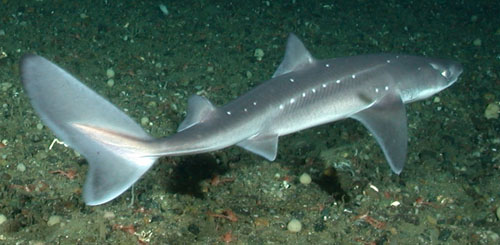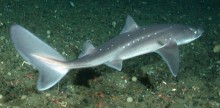— from Russel Barsh —
 Spiny Dogfish (Squalus acanthias) were historically one of the most abundant sharks in the world, including the Salish Sea. They hunt the seafloor like halibut, Pacific cod, and rockfish, but only in relatively shallow coastal waters, avoiding most of the open oceans. They can wander extensively, however, as recent tagging studies have confirmed.
Spiny Dogfish (Squalus acanthias) were historically one of the most abundant sharks in the world, including the Salish Sea. They hunt the seafloor like halibut, Pacific cod, and rockfish, but only in relatively shallow coastal waters, avoiding most of the open oceans. They can wander extensively, however, as recent tagging studies have confirmed.
Like rockfish, Spiny Dogfish can live long lives, often over 80 years. Females incubate their eggs internally, giving live birth to litters of about a half-dozen young sharks after a gestation period of roughly two years. Females tend to be larger and are more often taken commercially. Since Dogfish only begin mating in their twenties, the selective removal of larger, older females can have a devastatingly disproportionate impact on reproduction.
This seems to be what happened to North Atlantic Spiny Dogfish, valued for making fish and chips. By the 1990s this population had fallen to about 5 percent of historical levels. Here in the Salish Sea, we have not treated Dogfish any better. A large-scale commercial for vitamin-A-rich edible oils and fish meal reduced Dogfish numbers precipitously from the 1880s to 1980s. Salish Sea Dogfish numbers decreased even faster in the 1990s when Atlantic-caught Dogfish were no longer available. Dogfish are decreasing in size as well as abundance.
What is the connection with Indian Island? Dogfish rely on shallow nursery areas to raise their young, but commercial fishers targeted these nurseries much as the mid-20th century herring fishery targeted herring spawning grounds. Fishing Bay was a Dogfish nursery of considerable renown in the 1970s, but we have not encountered a single Dogfish there in six years of research!
Spiny Dogfish were designated a priority for action by the American Fisheries Society in 2000, and nearly a hundred fish biologists met at the University of Washington in 2005 to express their concern about the fate of this species. But like most sharks, Dogfish are not exactly cuddly. They are aggressive, prickly, toothy, and they compete with humans for a lot of what we like to eat… like wolves.
**If you are reading theOrcasonian for free, thank your fellow islanders. If you would like to support theOrcasonian CLICK HERE to set your modestly-priced, voluntary subscription. Otherwise, no worries; we’re happy to share with you.**









Thanks, Russel for your, as usual interesting and informative info on various sea creatures….
Interesting, but my experience (as a recreational fisherman) is that there are as many as ever, both large and small.
About ten years ago I remember seeing dogfish off of Youngren’s hatchery so thick it almost seemed you could walk to shore on their backs. I presume they were attracted by the salmon processing.